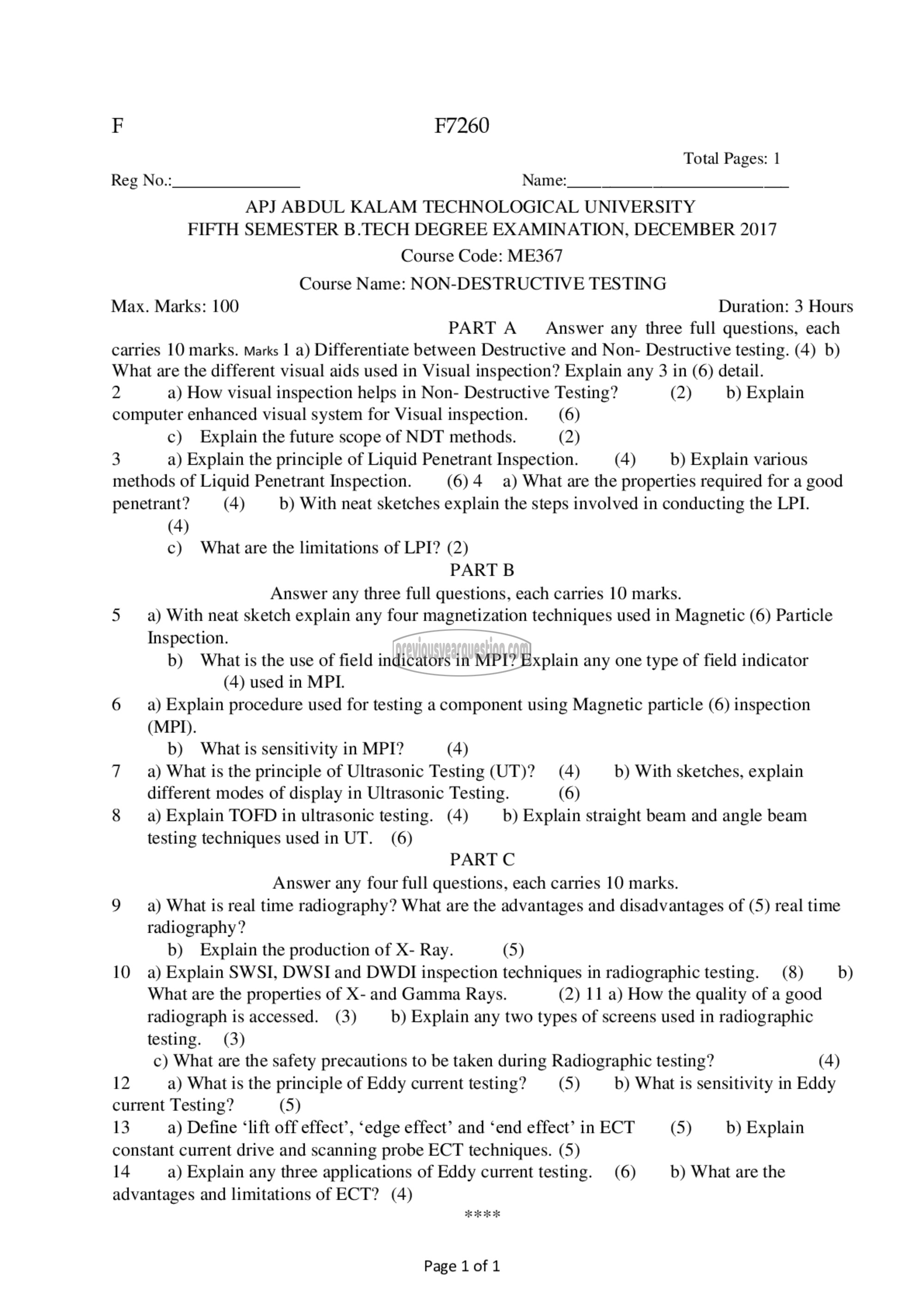APJ ABDUL KALAM TECHNOLOGICAL UNIVERSITY Previous Years Question Paper & Answer
Semester : SEMESTER 5
Subject : Non-Destructive Testing
Year : 2017
Term : DECEMBER
Branch : MECHANICAL ENGINEERING
Scheme : 2015 Full Time
Course Code : ME 367
Page:1
F F7260
Total Pages: 1
Reg No.: Name: _
APJ ABDUL KALAM TECHNOLOGICAL UNIVERSITY
FIFTH SEMESTER B.TECH DEGREE EXAMINATION, DECEMBER 2017
Course Code: ME367
Course Name: NON-DESTRUCTIVE TESTING
Max. Marks: 100 Duration: 3 Hours
PART A _ Answer any three full questions, each
carries 10 marks. Marks | a) Differentiate between Destructive and Non- Destructive testing. (4) b)
What are the different visual aids used in Visual inspection? Explain any 3 in (6) detail.
2 a) How visual inspection helps in Non- Destructive Testing? (2) b) Explain
computer enhanced visual system for Visual inspection. (6)
c) Explain the future scope of NDT methods. (2)
3 a) Explain the principle of Liquid Penetrant Inspection. (4) b) Explain various
methods of Liquid Penetrant Inspection. (6)4 a) What are the properties required for a good
penetrant? (4) b) With neat sketches explain the steps involved in conducting the LPI.
(4)
€) What are the limitations of LPI? (2)
PART B
Answer any three full questions, each carries 10 marks.
5 9) With neat sketch explain any four magnetization techniques used in Magnetic (6) Particle
Inspection.
b) What is the use of field indicators in MPI? Explain any one type of field indicator
(4) used in MPI.
6 93) Explain procedure used for testing a component using Magnetic particle (6) inspection
(MPI).
b) What is sensitivity in MPI? (4)
7 9७) What is the principle of Ultrasonic Testing (UT)? (4) b) With sketches, explain
different modes of display in Ultrasonic Testing. (6)
8 9) Explain TOFD in ultrasonic testing. (4) b) Explain straight beam and angle beam
testing techniques used in UT. (6)
PART ^
Answer any four full questions, each carries 10 marks.
9 9) What is real time radiography? What are the advantages and disadvantages of (5) real time
radiography?
b) Explain the production of X- Ray. (5)
10 a) Explain SWSI, DWSI and DWDI inspection techniques in radiographic testing. (8) b)
What are the properties of X- and Gamma Rays. (2) 11 a) How the quality of a good
radiograph is accessed. (3) b) Explain any two types of screens used in radiographic
testing. (3)
c) What are the safety precautions to be taken during Radiographic testing? (4)
12 a) What is the principle of Eddy current testing? (5) b) What is sensitivity in Eddy
current Testing? (5)
13 a) Define ‘lift off effect’, ‘edge effect’ and ‘end effect’ in ECT (5) b) Explain
constant current drive and scanning probe ECT techniques. (5)
14 a) Explain any three applications of Eddy current testing. (6) b) What are the
advantages and limitations of ECT? (4)
Page 1 of 1
